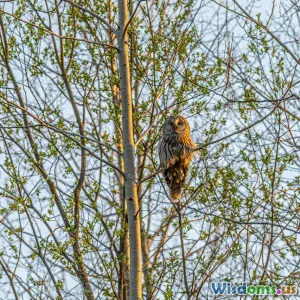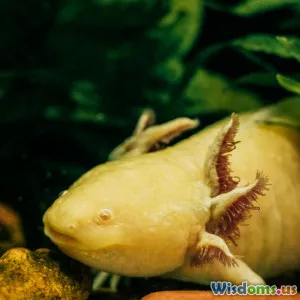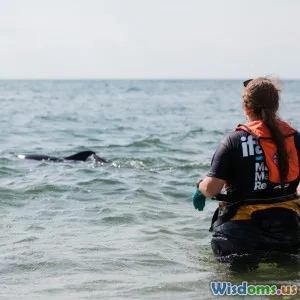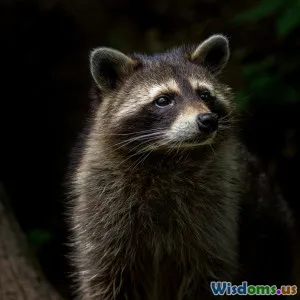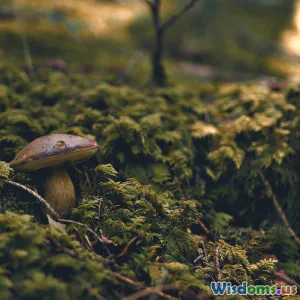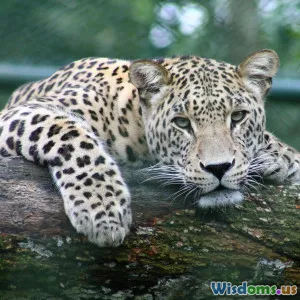
Beginner’s Guide to Analyzing Predator Prey Interactions
14 min read Explore the essentials of analyzing predator-prey interactions, including real-world examples, scientific methods, and beginner-friendly techniques to understand nature's dynamic balance. (0 Reviews)
Beginner’s Guide to Analyzing Predator-Prey Interactions
Introduction: The Chase that Shapes the Wild
Imagine a silent forest at dawn. Hidden in the shadows, a lynx stalks its prey—a timid snowshoe hare. As sharp eyes meet furred white, decades of evolution, survival strategies, and chance converge in a split second. This is more than just a hunt; it's a key engine powering ecosystems, driving species adaptation, and sculpting the delicate balance that defines nature.
For biologists and nature enthusiasts alike, analyzing predator-prey interactions opens a window onto these intricate tapestries, full of drama, strategy, and transformation. Yet, for those new to the science, these concepts can seem elusive. How do researchers decode the push-pull of predator and prey? Which patterns do they look for, and how do these insights shape our understanding of everything from biodiversity to food web stability?
This in-depth guide aims to equip you—a curious beginner—with the frameworks, real-world examples, models, and tools to analyze and appreciate predator-prey interactions. Whether you're a student, a budding naturalist, or someone with a keen interest in ecology, let's embark on a journey that transforms the ordinary hunt into a story of science, survival, and interdependence.
What Are Predator-Prey Interactions?
Defining the Terms
Predator-prey interactions represent relationships where one species (the predator) hunts, captures, and consumes another (the prey) for survival. These dynamics extend far beyond a simple chase: they encapsulate evolutionary arms races, population cycles, behavioral adaptations, and even ecosystem health.
Classic Examples:
- Canadian Lynx and Snowshoe Hare: Famous for their tightly linked population cycles.
- Wolves and Elk in Yellowstone National Park: Reintroduction of wolves sparked ripple effects throughout the ecosystem.
- Ladybugs and Aphids: Demonstrating interactions at a much smaller scale.
Each example reveals unique adaptations—stealth, speed, camouflage, intelligence—and the consequences these have for individuals and entire ecosystems.
Why Study Predator-Prey Interactions?
Understanding these interactions helps us:
- Predict population changes (Important for wildlife management and conservation).
- Conserve endangered species by recognizing threats or imbalances.
- Understand evolution as species adapt to each other's tactics and defense.
- Preserve ecosystems, since disruptions can affect biodiversity or trigger cascading effects.
Biologist Dr. Charles Krebs, whose work on the lynx–hare cycle reshaped ecological thinking, stated: “The origins of almost every ecological question start with ‘Who eats whom?'” Recognizing this, scientists treat predator-prey dynamics as a cornerstone of ecology.
Foundations: Key Theories and Concepts
1. The Lotka-Volterra Model: Nature's Math
Perhaps the simplest and most popular mathematical model to describe predator-prey dynamics is the Lotka-Volterra equations (developed in the 1920s by Alfred Lotka and Vito Volterra).
In a nutshell:
- Predator and prey populations are intrinsically linked; their numbers oscillate over time.
- Prey population grows when predators are scarce, leading to more food for predators.
- Predator population increases as their prey becomes abundant, but may crash when prey is depleted.
Case Study: Lynx and Hare Data
Historical records from the Hudson’s Bay Company trapping logs show how lynx and hare numbers have cycled in near-perfect synchrony—typically, peaks and troughs every 10 years—providing a real-world validation of Lotka-Volterra predictions.
“The oscillations in lynx and hare numbers became the textbook example of predator-prey dynamics, guiding research for decades.” — Canadian Journal of Zoology, 1986
2. Functional and Numerical Responses
- Functional Response: How a predator’s killing/eating rate changes with prey density.
- Numerical Response: How predator population fluctuates in response to prey availability.
For instance, when snowshoe hares are plentiful, lynx will catch and eat more, but there's a physical limit to how many hares a lynx can consume and digest in a day.
3. The Arms Race: Coevolution
Predator and prey often engage in a persistent cycle of adaptation—one evolving better detection or capture tactics, the other responding with heightened defenses or evasive behavior. Think zebras’ stripes as camouflage against lions, or poisonous newts and snakes evolving greater toxin resistance.
Patterns in Nature: Real-World Examples Explored
1. Terrestrial Mammals: Wolf and Elk in Yellowstone
In 1995, gray wolves were reintroduced to Yellowstone National Park after decades of absence. What followed stunned ecologists:
- Wolf predation reduced elk numbers, but more importantly, changed elk behavior—they avoided open valleys and riverbanks where wolves hunted most.
- Ripple Effects: Vegetation flourished along rivers. Willows and aspens recovered. This, in turn, boosted populations of beavers, birds, and fish—a phenomenon known as a trophic cascade.
“Wolves are a force of nature. They changed the behavior of rivers when they returned.” — Dr. Doug Smith, Yellowstone Wolf Project Lead Biologist
2. Insects: Ladybug and Aphid Dynamics
Ladybugs (predators) keep aphid populations (prey) in check. Gardeners and ecologists often introduce ladybugs to manage aphid infestations, showcasing how understanding predator-prey can have direct practical benefits.
Insights:
- Growth of aphid populations is rapid in absence of ladybugs.
- Ladybug introduction shifts the balance, curbing outbreaks.
3. Marine Systems: Sharks and Fish Schools
Predator-prey interactions are just as vital underwater. For example:
- Caribbean sharks: Influence not just prey fish populations, but indirectly impact coral reef health by controlling herbivore fish numbers.
- Sardine Run: Off South Africa, vast schools of sardines attract dolphins, sharks, and birds, peaking in a dramatic annual feeding frenzy—a dynamic, multi-species predator-prey system.
The Beginner’s Toolbox: Techniques & Approaches
How do scientists (and citizens) study these interactions? Here’s a toolkit accessible to those just starting out.
1. Observational Studies in the Field
- Direct Observation: Go into nature—watch, record, and tally interactions. What species do you see hunting or being eaten? Where does it happen? What time of day?
Example Activity:
Visit a lake, wetland, or backyard garden. Note predator and prey sightings. Keep a log: time, species, behaviors. Even backyard bird feeders reveal fascinating insights—see which birds chase others, or whether squirrels outsmart the blue jays.
2. Analyzing Patterns in Population Data
- Seek out population time series (records over many years) from nature reserves, science agencies, or online databases.
- Use graphing tools (even basic spreadsheet software) to plot predator and prey numbers against each other over time.
What to Look For:
- Lagged oscillations: Do prey numbers rise before predator peaks? Do they drop following a predator crash?
3. Simple Experiments
You don’t need a lab—small-scale experiments can happen in gardens or local parks.
- Set up ‘control’ (no predators) and ‘treatment’ (with predators) plots.
- Example: Use enclosures/netting to keep birds off certain plants; compare insect damage rates.
- For aquatic exploration, try observing tadpoles with or without fish, or snails with or without predatory beetles.
4. Citizen Science and Apps
Engage with community science projects:
- iNaturalist, eBird: Log observations of species, sometimes track predation events.
- Project FeederWatch: Helps study predator-prey at backyard bird feeders.
Crowdsourcing data from thousands of users uncovers patterns that single scientists might miss, contributing valuable information to ongoing ecological studies.
5. Mathematical Models for Beginners
Explore basic predator-prey simulations using free online tools:
- Lotka-Volterra calculators: Enter starting populations for hypothetical predators and prey, adjust parameters, and see cycles unfold.
- Population ecology games and apps: Interactive platforms (and some open-source projects like NetLogo) allow you to visually test how changes in birth, death, or hunting rates shift dynamics.
“Models start simple for a reason: they help you grasp the basics you’ll see in wild populations.” — Dr. Monica Turner, Ecologist
Key Variables and How to Measure Them
What makes predator–prey research both powerful and challenging is the complex interplay of variables. Here’s what to focus on:
1. Population Density
- Total number of individuals of predator and prey species per area/unit.
- Tools: Transect counts, camera traps, tracking devices.
2. Birth and Mortality Rates
- Estimate via fieldwork, review of existing data, or indirect clues (nests, carcass counts, predator scat analysis).
3. Predation Rate
- Number of prey killed or consumed per predator, per time period.
- Methods: Direct watch (field camps or hidden cameras), gut content analysis in labs, forensic-style examination of kill sites.
4. Habitat Structure
- Does vegetation, terrain, or water availability impact encounter rates or false ‘shelter’ effects?
- Real-world insight: In forests, dense undergrowth helps prey hide but may also limit food for both predator and prey.
5. Human Influence
- Fragmentation, hunting, pollution, or urbanization may disrupt established interactions.
- Example: Overfishing top predators can trigger explosions of their prey, leading to imbalance (as seen in marine food webs with the decline of sharks or cod).
Major Challenges and Complexities
1. Beyond the Classic Model: Real Life is Messy
While models like Lotka-Volterra assume neat, two-species systems, real ecosystems are layered, with:
- Multiple prey and predator species
- Switching behaviors—predators might target new prey if one is scarce
- Environmental disturbances—fire, drought, disease
“Nature’s interplay is less a duet, more an orchestra. Understanding it means watching the whole performance.” — Dr. Oswald Schmitz, Yale University
2. Indirect Effects: The Domino Principle
Predators sometimes benefit species far removed from their direct prey. In Yellowstone, wolves bolstered beaver and plant recovery by limiting elk—a chain reaction not obvious unless seen holistically.
3. Measuring Impact: The Cryptic Hunt
Many interactions are hidden, brief, or leave thin evidence. Tracking animals via GPS, tagging, or remote cameras advances the field, but can be costly and effortful.
How Your Insights Can Matter
Whether through classroom projects, informed wildlife watching, or contributing to citizen science, beginners hold the key to:
- Spotting unusual trends in species numbers or behaviors
- Alerting scientists to emerging imbalances
- Supporting conservation by documenting rare or threatened interactions
Get Involved:
- Join local ecology clubs or online science platforms
- Share your observations or photographs with research groups
- Be an advocate for predator and prey in policy or community forums
Conclusion: The Wild’s Balancing Act
Predator-prey interactions do not merely shape who eats whom. As windows into population health, ecosystem resilience, and evolutionary drama, they reveal nature’s capacity for both chaos and continuity.
By learning the core ideas, diving into the foundational models, and trying your hand at beginner-friendly studies, you gain not only scientific insights but a new perspective on the delicate choreography that sustains the living world.
So the next time you watch a hawk circle over a field, a fox dash through the brush, or crickets chirping as spiders lurk nearby, remember: these are pages from nature’s textbook, waiting for you to read—and perhaps, to write your own chapter in the ongoing exploration of predator and prey.
Rate the Post
User Reviews
Popular Posts











